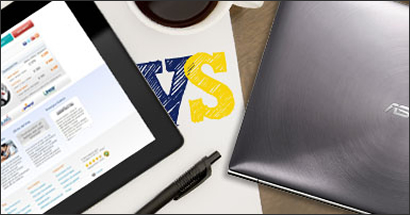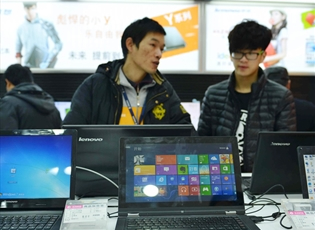Thought notebooks were dying off in favor of tablets? Nope. Turns out that people are buying laptops again, and combined notebook and tablet sales numbers have increased worldwide. This is despite a decline in tablet sales, as fewer consumers see reasons to upgrade their devices.
 Worldwide, 123.9 million PCs shipped in the second quarter (Q2) of this year, representing year-on-year growth of 14%, according to a new report from UK-based Canalys. But with no sequential growth, the positive effect that tablets have had on overall PC shipments is beginning to wear off.
Worldwide, 123.9 million PCs shipped in the second quarter (Q2) of this year, representing year-on-year growth of 14%, according to a new report from UK-based Canalys. But with no sequential growth, the positive effect that tablets have had on overall PC shipments is beginning to wear off.
Apple has continued to lead the market with a 14% market share, though a 10% increase in Mac shipments could not make up for a decline in iPad sales, resulting in the company’s overall shipments declining by 5%.
Lenovo had another impressive quarter, with shipments up almost 20% year on year, boosting its share to just below 14% – some 780,000 units behind Apple.
Rounding off the top four, both HP and Dell posted year-on-year increases in shipments, at 11% and 14% respectively, leading to sequential increases in market share, reports Canalys.
Falling tablet sales
Worldwide tablet shipments fell approximately 5% sequentially to 48.4 million units, as Apple and Samsung suffered shipment declines, according to Canalys. Apple shipped just under 13.3 million iPads in its weakest quarter since Q1 2012. Samsung shipped just under 8.9 million tablets — a sequential decline, though not quite as sharp as Apple’s. Apple and Samsung continue to account for 46% of global tablet shipments, and as a result many markets hinge on their combined success.
Tablet shipments in Asia Pacific (including China) came in 8% below Q1 2014 numbers, mainly due to a fall in shipments by the leading pair, says Canalys. Conversely, both companies fared better in the US, and, as a result, tablet shipments there increased 4% quarter on quarter. Shipments in EMEA fell approximately 11% year on year, with declines in Central and Eastern Europe, and Western Europe negating growth in the Middle East and Africa.
We’ve seen this all before
“The tablet market has quickly found itself in the same position the notebook market was in some years ago, with minimal increases in hardware performance forming the basis for an argument to upgrade,” says Canalys Senior Analyst Tim Coulling. “But when considering the most common tasks that tablets are asked to perform, the need for more horsepower is often not evident. [Tablet makers] will need to work harder to give reasons to upgrade if things are to improve. And as smart phone screen sizes increase, the potential [is there] for such products to disrupt the market for 7″ tablets.”
“Pricing remains Apple’s biggest barrier to growth and essentially locks it out of a number of markets,” says Canalys Research Analyst Rushabh Doshi. “But as sales in its key markets slow, it is betting on the improving economic environment in high-growth markets, such as China, to drive future growth.”
Samsung faces a different challenge: it is fighting battles on all fronts as it attempts to compete in a wide range of market segments. “The release of the Galaxy Tab S line saw it add Super AMOLED screens to its tablet offerings as well as introduce a new 10.5″ screen to its portfolio. With Samsung playing in so many segments, it is able to find pockets of demand. But it also drives obsolescence in other areas of its portfolio, causing inventory buildup that necessitates rounds of promotional activity,” says Doshi.
Notebook sales resurgence
The notebook market enjoyed a resurgence in Q2 2014, with shipments all but flat on the same quarter a year ago. With 49.1 million units shipped in the quarter, notebook shipments surpassed those of tablets for the first time since Q3 2013. Shipments in North America and EMEA were up 13% and 8% year on year, helped by good growth in Western Europe and the US.
Canals attributes the growth in developed markets to a few factors. Improving economic conditions and ongoing XP migration continue to drive a refresh in the corporate space. Chromebooks are gaining traction, with increasing demand from consumers and education, especially in the US. Intel’’ Atom-based Bay Trail platform and the falling price of touch-screens are driving down the cost of consumer notebooks.
“Consumers can expect further price cuts in the second half of 2014 as Microsoft responds to the increasing threat from Google,” predicts Coulling. “It has dropped licensing costs on small form-factor tablets and announced ‘Windows with Bing,’ which will provide Windows for free on low-cost notebooks. Falling prices are great for consumers but will do nothing to ease the pain for vendors, whose margins are under constant pressure.”




